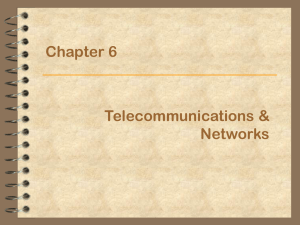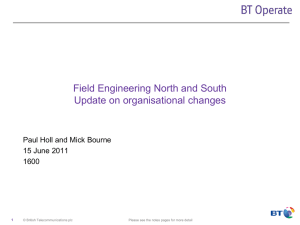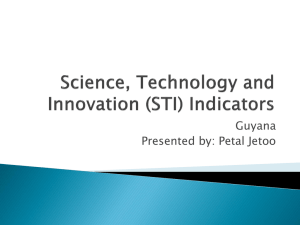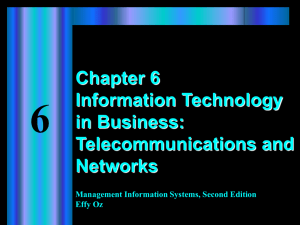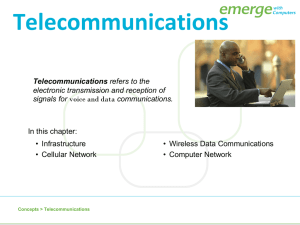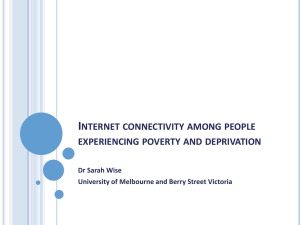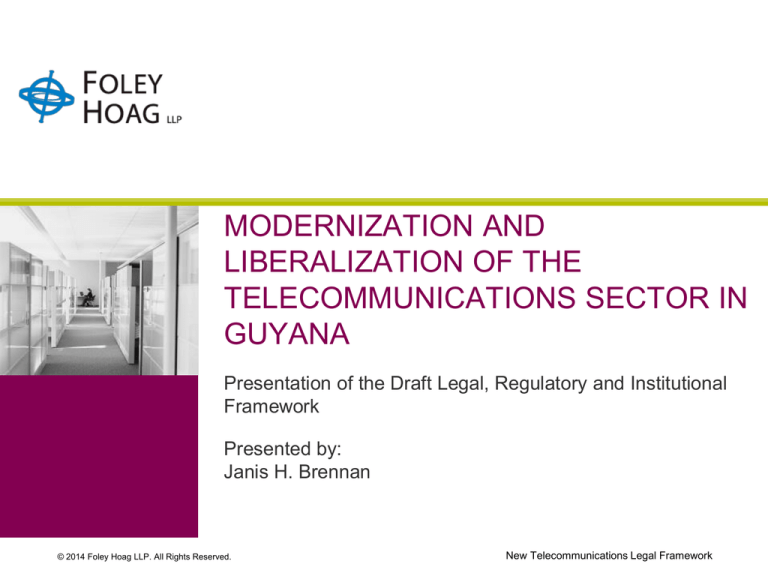
MODERNIZATION AND
LIBERALIZATION OF THE
TELECOMMUNICATIONS SECTOR IN
GUYANA
Presentation of the Draft Legal, Regulatory and Institutional
Framework
Presented by:
Janis H. Brennan
© 2014 Foley Hoag LLP. All Rights Reserved.
New Telecommunications Legal Framework
Outline
THE PROCESS OF TELECOMMUNICATIONS SECTOR
REFORM
– Timeline
– Government’s Goals for Sector Reform
THE NEW LEGAL, REGULATORY AND INSTITUTIONAL
FRAMEWORK FOR THE TELECOMMUNICATIONS SECTOR IN
GUYANA
– Legal and Regulatory Framework
– Institutional Arrangements
– Licensing Provisions
– Prices
– Dominance and Joint Dominance
– Interconnection and Access
– Universal Access and Universal Services
© 2014 Foley Hoag LLP. All Rights Reserved.
New Telecommunications Legal Framework | 2
Outline
THE NEW LEGAL, REGULATORY AND INSTITUTIONAL
FRAMEWORK FOR THE TELECOMMUNICATIONS SECTOR IN
GUYANA (cont.)
– Spectrum Management
– Terminal Equipment, Testing and Inspection
– Competitive Safeguards
– Consumer Protection
– Offenses and General Provisions
– Transitional Provisions
© 2014 Foley Hoag LLP. All Rights Reserved.
New Telecommunications Legal Framework | 3
THE PROCESS OF
TELECOMMUNICATIONS SECTOR
REFORM
© 2014 Foley Hoag LLP. All Rights Reserved.
New Telecommunications Legal Framework | 4
The Process of Telecommunications Sector
Reform in Guyana
Timeline
1990-1
• Telecommunications Act and Public Utilities Commission
Act
• Establishment of GT&T and PUC
• Sale of 80% of GT&T to ATN; Government retains 20%
• Licence granted to GT&T under new Telecommunications
Act
1994
• WTO (Marrakech) Agreement on Trade in Services
(GATS). Guyana makes telecommunications services
commitment (on-line information and data base retrieval, a
value added service)
1999
• Public Utilities Commission Act amended
© 2014 Foley Hoag LLP. All Rights Reserved.
New Telecommunications Legal Framework | 5
The Process of Telecommunications Sector
Reform in Guyana
Timeline
2000
• “Modernisation of the Telecommunications Sector”
initiative launched by the Government
2001
• Government issues a “Consultation Paper on the Issues
and Options for Reform of the Telecommunications
Sector” and initiates a public consultation
• U Mobile (owned by Cel*Star) granted a cellular mobile
license
2002
• Draft National Telecommunications Policy
2004
• U Mobile begins offering cellular mobile services in
competition with GT&T
2006
• ICT for Development Strategy
2007
• Digicel acquires Cel*Star/U Mobile and begins to
compete aggressively with GT&T
© 2014 Foley Hoag LLP. All Rights Reserved.
New Telecommunications Legal Framework | 6
The Process of Telecommunications Sector
Reform in Guyana
Timeline
2009
• The EU and Caricom sign an EPA (Economic Partnership
Agreement) that commits Guyana to open telecommunications
markets to European and Caribbean operators and service
providers in many areas
• Work begins on comprehensive new legal framework for Guyana
telecommunications sector
2010
• Government pursues “E-Government” project
• ATN (majority owner of GT&T) lays and brings new undersea
cable into operation
© 2014 Foley Hoag LLP. All Rights Reserved.
New Telecommunications Legal Framework | 7
The Process of Telecommunications Sector
Reform in Guyana
Government’s Goals for Sector Reform
• Guyana’s full participation in the Information Society requires that
all citizens have easy, affordable and ubiquitous access to
telecommunications services
–
–
–
Essential to national development; ICT’s own contribution, plus its
role in support of other sectors
Universally agreed that this is best achieved through a vibrant, open,
competitive telecommunications market
Need to expand service possibilities and offerings
• Reform process completed or actively underway in most other
countries in the world including the Caribbean. As of today only
The Bahamas, Guyana, and Haiti in the Caribbean have not taken
significant steps to liberalize, or fully liberalized, their
telecommunications markets
© 2014 Foley Hoag LLP. All Rights Reserved.
New Telecommunications Legal Framework | 8
The Process of Telecommunications Sector
Reform in Guyana
Government’s Goals for Sector Reform
• Much of the Telecommunications Act 1990 and even parts of PUC
Act 1999 are outdated in light of the rapid technical and institutional
changes in the telecommunications sector
–
–
These Acts largely envision regulation of monopolies, not open,
competitive markets, and contain inconsistencies
There is a need to create a legal regime that will support an open,
competitive telecommunications market with a level playing field for all
market participants and that will regularize the existing market that has
developed over time as technologies have developed
© 2014 Foley Hoag LLP. All Rights Reserved.
New Telecommunications Legal Framework | 9
THE NEW LEGAL, REGULATORY AND
INSTITUTIONAL FRAMEWORK FOR
THE TELECOMMUNICATIONS
SECTOR IN GUYANA
© 2014 Foley Hoag LLP. All Rights Reserved.
New Telecommunications Legal Framework | 10
The New Legal, Regulatory and Institutional Framework
for the Telecommunications Sector in Guyana
Legal and Regulatory Framework
• Consists of:
A. The Telecommunications Act and harmonizing amendments to PUC Act
B. Regulations
i.
ii.
iii.
iv.
v.
vi.
vii.
Licensing
Interconnection and Access
Pricing
Universal Access and Universal Services
Spectrum Management
Competitive Safeguards
Consumer Protection
C. New licenses and frequency authorisations to be issued under the new
legislation to GT&T, Digicel and four existing ISPs – see section 93(6)(a)
of draft Telecommunications Act
D. Model licenses and frequency authorisations
E. Telecommunications Code
© 2014 Foley Hoag LLP. All Rights Reserved.
New Telecommunications Legal Framework | 11
The New Legal, Regulatory and Institutional Framework
for the Telecommunications Sector in Guyana
Institutional Arrangements
• Minister
− Develops policy
− Determines what types of networks and services require licenses
− Grants or denies applications for licenses and frequency
authorisations
− Makes regulations
− Oversees the new Telecommunications Agency (“Agency”)
− Responsible for representing Guyana’s telecommunications
interests internationally
© 2014 Foley Hoag LLP. All Rights Reserved.
New Telecommunications Legal Framework | 12
The New Legal, Regulatory and Institutional Framework
for the Telecommunications Sector in Guyana
Institutional Arrangements
• Agency (technical regulator; headed by a Director)
− Implements the Minister’s policy directives
− Receives, reviews, and makes recommendations on applications
for licenses and frequency authorisations
− Advises and supports Minister on matters related to policy,
licenses, spectrum and international relations
− Monitors and enforces compliance with licenses and frequency
authorisations
− Manages the spectrum (plan, supervise, regulate, monitor
harmful interference) and other technical aspects of
telecommunications including numbers
− Administers the Universality Fund and universal access/services
program
© 2014 Foley Hoag LLP. All Rights Reserved.
New Telecommunications Legal Framework | 13
The New Legal, Regulatory and Institutional Framework
for the Telecommunications Sector in Guyana
Institutional Arrangements
• PUC (economic regulator)
−Regulates wholesale and retail prices for telecommunications
networks and services
−Regulates interconnection and access
−Regulates number portability and equal access
−Enforces competitive safeguards
−Resolves disputes involving operators and service providers
−Protects consumers and resolves disputes between
consumers and service providers
© 2014 Foley Hoag LLP. All Rights Reserved.
New Telecommunications Legal Framework | 14
The New Legal, Regulatory and Institutional Framework
for the Telecommunications Sector in Guyana
Licensing Provisions
• Guiding principles
− Public networks and services will have to be licenced; separate
license, or license amendment, required to land and operate a
cable
− No licenses will be required for networks/services used solely
within a company and not being operated to provide public
telecommunications services - Private networks and services
− Frequency authorisations will be required for the use of the
spectrum and the operation of radiocommunication equipment
except if exempted by order of the Minister (e.g., use by general
public of wireless consumer products)
© 2014 Foley Hoag LLP. All Rights Reserved.
New Telecommunications Legal Framework | 15
The New Legal, Regulatory and Institutional Framework
for the Telecommunications Sector in Guyana
Licensing Provisions
• Three types of licences under the new framework
− Individual licenses will be required to operate a public
telecommunications network or provide public
telecommunication services
− Class licenses may be authorized for certain public
telecommunications networks and certain public
telecommunications services as determined by the Minister
(e.g., ISPs, Internet cafes, value-added services)
− Special licenses and related frequency authorisations will be
permitted in emergencies and other exigent circumstances and
for demonstration/testing and other short term situations; valid
for 10-days; renewable for good cause
© 2014 Foley Hoag LLP. All Rights Reserved.
New Telecommunications Legal Framework | 16
The New Legal, Regulatory and Institutional Framework
for the Telecommunications Sector in Guyana
Licensing Provisions
• Exemptions
− The Minister may exempt networks and services for a class or
description of operators from requiring a licence; to be designated
in orders
− Exemptions must be applied on a non-discriminatory basis and
must be available for public scrutiny
• Dealer permits
− To be required for the sale or other transfer or programming or
other modification of radiocommunication equipment – purpose is
to monitor compliance with international standards, safety, and
non-interference
© 2014 Foley Hoag LLP. All Rights Reserved.
New Telecommunications Legal Framework | 17
The New Legal, Regulatory and Institutional Framework
for the Telecommunications Sector in Guyana
Licensing Provisions
• Terms and conditions of licenses and frequency authorisations
− No set limit on numbers
− Transparent and non-discriminatory terms and conditions; level playing field
− Agency recommends; Minister approves or denies application after public
comment period
− Obligations attached to licenses and frequency authorisations include
requirement to comply with Act, regulations, the Telecommunications Code
and other relevant laws; restrictions on assignment, sale or transfer of
ownership; requirement to pay fees
− Obligations attached to frequency authorisations: respect technical
parameters of frequencies assigned; adhere to authorized frequency bands,
etc.
© 2014 Foley Hoag LLP. All Rights Reserved.
New Telecommunications Legal Framework | 18
The New Legal, Regulatory and Institutional Framework
for the Telecommunications Sector in Guyana
Licensing Provisions
• New Act contains provisions on:
− Suspension or termination of licenses and frequency authorisations
− Amendments to licenses and frequency authorizations
− Renewal of licenses and frequency authorisations
© 2014 Foley Hoag LLP. All Rights Reserved.
New Telecommunications Legal Framework | 19
The New Legal, Regulatory and Institutional Framework
for the Telecommunications Sector in Guyana
Licensing Provisions
• Authorization to operate in territorial waters or airspace
− Provisions of Act, regulations and Telecommunications Code
apply to all ships, aircraft and other vessels registered in Guyana
and their use of the spectrum or radiocommunication equipment
− Not required for ships, aircraft and other vehicles not registered
in Guyana while operating in the territorial waters and airspace of
Guyana, so long as they have a valid frequency authorisation
issued by a foreign governmental authority in accordance with
international agreements (however, will be under the jurisdiction
the Agency while in Guyana)
© 2014 Foley Hoag LLP. All Rights Reserved.
New Telecommunications Legal Framework | 20
The New Legal, Regulatory and Institutional Framework
for the Telecommunications Sector in Guyana
Licensing and Frequency Authorisation
(Telecommunications) Regulations
• Lay out the general principles on licensing/frequency authorisations
embodied in the Act
• Describe the requirements and procedure for applying for and obtaining
licences, frequency authorisations, dealers’ permits and certificates of
competence, and their adjudication, incl. time table
• Describe the roles of the Minister and the Agency in the licensing and
frequency authorisation process.
• Provide criteria to be considered in deciding whether to grant or deny an
application (e.g., applicant’s technical and operational qualifications,
experience, ability to establish and bring the relevant network/services
into operation within a defined time, the markets for the services, etc.)
© 2014 Foley Hoag LLP. All Rights Reserved.
New Telecommunications Legal Framework | 21
The New Legal, Regulatory and Institutional Framework
for the Telecommunications Sector in Guyana
Licensing and Frequency Authorisation
(Telecommunications) Regulations
• Recognize that some licenses and frequency authorisations may be
granted on the basis of a competitive process
• Include provisions on fees and the maintenance of a registry of all
licences, frequency authorisations, permits and certificates
• Include provisions on offences and penalties
• Attach (in the Schedules) standard application forms for individual
licences, class licences, special licences, exemptions and frequency
authorisations
• Applicants, licencees and authorisation holders have an obligation to
inform Agency of material changes in information included in
application
© 2014 Foley Hoag LLP. All Rights Reserved.
New Telecommunications Legal Framework | 22
The New Legal, Regulatory and Institutional Framework
for the Telecommunications Sector in Guyana
Licences and Frequency Authorisations
•
Principle characteristics
-
Not complex documents because Guyana will have a well-developed
legal regime that clearly spells out the conditions under which licences
and frequency authorisations are awarded and the attached
obligations on operators, service providers and authorisation holders
-
Virtually the same for all types of operators and service providers
transparency and non discrimination levels the playing field
Differences among licences and frequency authorisations arise only due
to:
whether the licensee is an operator (i.e, networks) or a service
provider (i.e., services), or both
o
-
o
o
the importance of the licensed activity to the development of
telecommunications in Guyana (e.g., universal access/universal
services obligations, dominance/joint dominance)
© 2014 Foley Hoag LLP. All Rights Reserved.
New Telecommunications Legal Framework | 23
The New Legal, Regulatory and Institutional Framework for the
Telecommunications Sector in Guyana
Licences and Frequency Authorisations
•
New licences and frequency authorisations which will be
awarded under the new regime (on the Effective Date of new
Act)
–
New GT&T licence and frequency authorisation to replace existing
licence (1990) and various documents authorising GT&T to use
spectrum
–
New Digicel licence and frequency authorisation to replace existing
2001 licence and authorisation for Digicel to use spectrum
Licences and frequency authorisations for four ISPs operating wireless
broadband Internet access networks
Model licences for the following types of operators and service
providers: fixed network and services (PSTN), mobile networks and
services, international services, domestic services, mobile services,
value added services, and resale of services
–
–
–
Model frequency authorisation
© 2014 Foley Hoag LLP. All Rights Reserved.
New Telecommunications Legal Framework | 24
The New Legal, Regulatory and Institutional Framework
for the Telecommunications Sector in Guyana
Prices
• Scope of application
− Public telecommunications networks and public
telecommunications services (retail and, in limited
circumstances, wholesale)
• Basic principles for regulating prices
– Prices are set by market participants on the basis of supply and
demand
– Price regulation in cases of sole provider, dominance, anticompetitive cross-subsidization or other anti-competitive or
unfair behaviour, other instances identified in Pricing
Regulations
© 2014 Foley Hoag LLP. All Rights Reserved.
New Telecommunications Legal Framework | 25
The New Legal, Regulatory and Institutional Framework
for the Telecommunications Sector in Guyana
Prices
• Basic principles for regulating prices
− Within a framework designed to ensure:
o
o
transparency, non-discrimination, fairness and provide
certainty for consumers and market participants alike
clarity of implementation by regulator, operators and service
providers
© 2014 Foley Hoag LLP. All Rights Reserved.
New Telecommunications Legal Framework | 26
The New Legal, Regulatory and Institutional Framework
for the Telecommunications Sector in Guyana
Pricing (Telecommunications) Regulations
• Lay out and elaborate on the general principles governing prices
in the Act
• Existing prices will remain in effect until changed in accordance
with the Act and Regulations – Resets the legal regime
• Notice to the PUC before any price change is effected; PUC has
14 days to decide whether it wishes to regulate the price
• Yearly public education sessions to be held by PUC
© 2014 Foley Hoag LLP. All Rights Reserved.
New Telecommunications Legal Framework | 27
The New Legal, Regulatory and Institutional Framework
for the Telecommunications Sector in Guyana
Pricing (Telecommunications) Regulations
• Regulation of prices limited to instances of sole provider of a network or
service, dominance, and anti-competitive and other unfair behaviour
• PUC to identify markets for price regulation
• Price control
− First 3 years – Ceilings and floors
− After first 3 years, price caps – the preferred method worldwide because
it provides a built-in incentive for the operator or service provider to
become more efficient (sometimes combined with price floors)
− If fair and reasonable prices cannot be set using a price cap regime, the
PUC may utilize rate of return (for retail prices) or retail minus (for
wholesale prices) methodologies
© 2014 Foley Hoag LLP. All Rights Reserved.
New Telecommunications Legal Framework | 28
The New Legal, Regulatory and Institutional Framework
for the Telecommunications Sector in Guyana
Pricing (Telecommunications) Regulations
• Detailed, internationally-accepted formulas for price caps and
the other price control regimes are attached as Schedules to the
Regulations – Provides predictability and stability
• Procedures for setting and reviewing price control regimes
• Offenses and penalties
© 2014 Foley Hoag LLP. All Rights Reserved.
New Telecommunications Legal Framework | 29
The New Legal, Regulatory and Institutional Framework
for the Telecommunications Sector in Guyana
Dominance and Joint Dominance
• In many instances, competition is best promoted by regulating
only those telecommunications operators and service
providers that are dominant (or jointly dominant), i.e., those
operators and service providers that have the economic power
(either alone or jointly with another operator/service provider)
to influence the market without constraints from competitors,
potential competitors, or consumers
• It is not necessary to place the same regulatory burden on
operators and service providers who do not have the power to
influence the market without those constraints
© 2014 Foley Hoag LLP. All Rights Reserved.
New Telecommunications Legal Framework | 30
The New Legal, Regulatory and Institutional Framework
for the Telecommunications Sector in Guyana
Dominance and Joint Dominance
•
Definition of “dominance”
– Where “a telecommunications undertaking, by itself or
together with an affiliated telecommunications
undertaking or group of affiliated telecommunications
undertakings, occupies such a position of economic
strength as will enable it to operate in such market
without effective constraints from its competitors,
potential competitors, consumers or other users”
– Consistent with definition of “dominance” in Competition
and Fair Trading Act 2006, which in turn is consistent
with Treaty of Chaguramas
© 2014 Foley Hoag LLP. All Rights Reserved.
New Telecommunications Legal Framework | 31
The New Legal, Regulatory and Institutional Framework
for the Telecommunications Sector in Guyana
Dominance and Joint Dominance
•
Definition of “joint dominance”
– Two or more telecommunications undertakings hold a
jointly dominant position in any market where “those
telecommunications undertakings jointly occupy such a
position of economic strength as will enable them,
individually or jointly, to operate in such market without
effective constraints from their competitors, potential
competitors, consumers or other users.”
© 2014 Foley Hoag LLP. All Rights Reserved.
New Telecommunications Legal Framework | 32
The New Legal, Regulatory and Institutional Framework
for the Telecommunications Sector in Guyana
Dominance and Joint Dominance
•
Concepts of “dominance” and “joint dominance” are implicated
in the pricing, interconnection and access, and competition
provisions of the Act and in the –
–
–
•
Pricing (Telecommunications) Regulations
Interconnection and Access (Telecommunications) Regulations
Competition (Telecommunications) Regulations
Clarification that regulation of dominance, joint dominance and
competition in the telecommunications sector rests with the
PUC (not the Competition Commission under the Competition
and Fair Trading Act 2006) – However, PUC standards are
harmonized with Competition Commission standards, and two
commissions are required to cooperate with one another
© 2014 Foley Hoag LLP. All Rights Reserved.
New Telecommunications Legal Framework | 33
The New Legal, Regulatory and Institutional Framework
for the Telecommunications Sector in Guyana
Interconnection and Access
• Applies to:
1. Interconnection of public telecommunications networks
2. Access to facilities of telecommunications operators and
service providers
3. Access to utility installations of other public utilities (e.g.,
GPL) and vice versa
4. Collocation of telecommunications facilities and public utility
installations (e.g., utility poles, conduits, physical space in a
telephone company’s switching centre, etc.)
• Interconnection and Access (Telecommunications)
Regulations
© 2014 Foley Hoag LLP. All Rights Reserved.
New Telecommunications Legal Framework | 34
The New Legal, Regulatory and Institutional Framework
for the Telecommunications Sector in Guyana
Interconnection and Access
• Obligations on all operators, service providers and public
utilities
– Must offer and provide interconnection and access on a non-discriminatory,
timely basis to all other operators and service providers
– Must allow direct and indirect interconnection of other networks and services
– Must comply with regulations and with standards and prices established by
PUC
– Must submit copies of interconnection and access agreements to PUC. PUC
must make these publicly available
– PUC to resolve any disputes over interconnection and access
© 2014 Foley Hoag LLP. All Rights Reserved.
New Telecommunications Legal Framework | 35
The New Legal, Regulatory and Institutional Framework
for the Telecommunications Sector in Guyana
Interconnection and Access
• Obligations on all operators, service providers and public
utilities
– Must submit disputes to PUC for resolution and comply with its
decisions; PUC can dictate terms of interconnection, access,
joint use and collocation agreements if parties have not agreed
to them within a specified time
– Must provide equal access to consumers using services of
another service provider (equal access ability of consumer to
freely choose among competing service providers)
© 2014 Foley Hoag LLP. All Rights Reserved.
New Telecommunications Legal Framework | 36
The New Legal, Regulatory and Institutional Framework
for the Telecommunications Sector in Guyana
Interconnection and Access
• Prices for interconnection and access
–
Access must be provided by all operators and service
providers on a disaggregated and unbundled basis,
e.g., prices must be based on what is actually involved
in the access, not the entire network/services
–
Dominant operators and services providers must also:
o
provide access at cost-oriented prices
o
provide interconnection at prices that are costoriented, disaggregated and unbundled
© 2014 Foley Hoag LLP. All Rights Reserved.
New Telecommunications Legal Framework | 37
The New Legal, Regulatory and Institutional Framework
for the Telecommunications Sector in Guyana
Interconnection and Access
(Telecommunications) Regulations
• Regulations also define:
– Contents of Interconnection and Access Agreements
– Procedures (including timetables) for negotiating and
implementing interconnection and access agreements
– Procedures for resolving disputes concerning
interconnection, access, joint use and collocation
© 2014 Foley Hoag LLP. All Rights Reserved.
New Telecommunications Legal Framework | 38
The New Legal, Regulatory and Institutional Framework
for the Telecommunications Sector in Guyana
Universal Access and Universal Services
• Objectives
− Ensure access to telecommunications networks and
services for all citizens irrespective of where they live or
their income
− Contribute to the economic and social development of
Guyana
− Promote information-based applications in education,
health and other key public sectors
− Promote technology innovation and competition in the
sector
− Carry out on a staged basis
© 2014 Foley Hoag LLP. All Rights Reserved.
New Telecommunications Legal Framework | 39
The New Legal, Regulatory and Institutional Framework
for the Telecommunications Sector in Guyana
Universal Access and Universal Services
• Universal access (Definition)
− The reasonable availability of telecommunications
networks and telecommunications services on either a
private or a shared, public basis to individuals and
enterprises within a given community
• Universal services (Definition)
− The ubiquitous delivery, accessibility and affordability of
telecommunications services to persons throughout a
geographical area, with no practical impediments to
subscription and usage
© 2014 Foley Hoag LLP. All Rights Reserved.
New Telecommunications Legal Framework | 40
The New Legal, Regulatory and Institutional Framework
for the Telecommunications Sector in Guyana
Universal Access and Universal Services
• General principles governing universal access and
universal services
–
To be identified and implemented in an objective, transparent,
non discriminatory and technologically-neutral manner
–
Projects will be eligible for subsidies from the Universality Fund
• Universal Access and Universal Services
(Telecommunications) Regulations
–
Comprehensive, dynamic framework for achieving universal
access and universal services
© 2014 Foley Hoag LLP. All Rights Reserved.
New Telecommunications Legal Framework | 41
The New Legal, Regulatory and Institutional Framework
for the Telecommunications Sector in Guyana
Universal Access and Universal Services
• Universality Fund
− Fund for subsidizing the development, implementation and
operation of universal access and universal services projects
− Source of funds:
• Annual contributions in a percentage (3% maximum) of
gross annual revenues from each operator and service
provider
• Appropriations from National Treasury
• Other grants, donations, bequests, etc.
− Procedures for budgeting, accounting, awarding of subsidies,
and auditing the Fund are described in the Regulations and
administered by the Agency
− Competitive selection processes
© 2014 Foley Hoag LLP. All Rights Reserved.
New Telecommunications Legal Framework | 42
The New Legal, Regulatory and Institutional Framework
for the Telecommunications Sector in Guyana
Universal Access and Universal Services
• Identified Universal Services
− The minimum set of services of specified quality that should be
made available to all users regardless of their geographical
location, free or at an affordable price
− List initially to include:
1. Access to a high quality public telephone service (incl., free on-line
or printed telephone directory and operator assisted directory
enquiry and information services)
2. 24-hour free access to emergency telephone services
3. Special arrangements for the blind and other differently-abled
persons
© 2014 Foley Hoag LLP. All Rights Reserved.
New Telecommunications Legal Framework | 43
The New Legal, Regulatory and Institutional Framework
for the Telecommunications Sector in Guyana
Universal Access and Universal Services
• Functions and Responsibilities
− Minister, in consultation with the Agency
o
o
o
o
o
Determines networks and services to which requirement of
universal access and universal services will apply
Approves biennial plan of universal access and universal
services projects
Determines services to be included in the list of services
and how they are to be provided
Designates in a transparent and non-discriminatory manner
one or more operators and service providers to provide
services
Issues orders directed to operators and service providers
for provision of universal access and/or universal services
© 2014 Foley Hoag LLP. All Rights Reserved.
New Telecommunications Legal Framework | 44
The New Legal, Regulatory and Institutional Framework
for the Telecommunications Sector in Guyana
Universal Access and Universal Services
• Functions and Responsibilities
− Agency
o
o
o
o
o
Consults with stakeholders and Fund Advisory Committee to
identify and select projects intended to achieve objectives of
universal access and universal services
Develops, and submits for approval of the Minister, the biennial
plan of projects eligible for subsidies from Universality Fund
Advises the Minister on services to be included in or removed
from the list of universal access/services
Administers the Universality Fund and the universal
access/services program
Monitors performance of universal access and universal services
obligations
© 2014 Foley Hoag LLP. All Rights Reserved.
New Telecommunications Legal Framework | 45
The New Legal, Regulatory and Institutional Framework
for the Telecommunications Sector in Guyana
Universal Access and Universal Services
• Functions and Responsibilities
– Fund Advisory Committee
o Membership:
Director of Agency (Chairman) and Deputy Director (Vice-Chair)
Representatives of Ministries of Finance, Home Affairs, Labour,
Health, Education, Local Government/Regional Development,
Amerindian Affairs
Representative of consumer advocate groups
Representatives of operators and service providers
o
Meets when required but at least twice a year
o
Advises the Agency on projects to be included in biennial
program of universal access and universal services projects
© 2014 Foley Hoag LLP. All Rights Reserved.
New Telecommunications Legal Framework | 46
The New Legal, Regulatory and Institutional Framework
for the Telecommunications Sector in Guyana
Spectrum Management
• General Principles
− Spectrum will be allocated and assigned to:
o
o
o
Ensure its efficient use
Take into account the likely impact on current and future requirements
for spectrum in Guyana
Comply with Guyana’s international, regional, and bilateral obligations
− Two types of fees, established by the Agency:
o
o
Authorization fee
Usage fee
− Agency will monitor harmful interference and may enter and inspect and
order users to suspend operation of equipment causing interference
© 2014 Foley Hoag LLP. All Rights Reserved.
New Telecommunications Legal Framework | 47
The New Legal, Regulatory and Institutional Framework
for the Telecommunications Sector in Guyana
Spectrum Management
• Spectrum Plan (Allocation of frequencies)
− Established and maintained by the Agency subject to approval
by the Minister
− Contains information, rules and procedures for allocating
frequencies including:
o
o
o
o
o
o
o
Table of Frequency Allocations
Technical parameters of particular bands of frequencies
Procedures on assigning frequencies including length of term, termination,
authorization fees
Arrangements for visitors using radio transmitting devices
Bands reserved for use by Government, Police and Defence Force
Uses for which no authorization will be required (e.g., consumer products)
Bands reserved for shared and sole use
© 2014 Foley Hoag LLP. All Rights Reserved.
New Telecommunications Legal Framework | 48
The New Legal, Regulatory and Institutional Framework
for the Telecommunications Sector in Guyana
Spectrum Management
• Spectrum Plan (allocation of frequencies) – cont.
– Allocation and reallocation of frequencies
o Agency, with Minister’s approval, may allocate and reallocate
frequencies
o May amend frequency authorisations when frequencies are
reallocated
• Assignment (authorization of use) of frequencies
o
o
Procedures and fees determined by Agency (with approval of
Minister)
Methods: auctions, tenders, fixed prices, first come first served
or on the basis of stated criteria
• Spectrum Management Regulations
o Contain detailed provisions on all of the above points, plus
offenses and further enforcement powers
© 2014 Foley Hoag LLP. All Rights Reserved.
New Telecommunications Legal Framework | 49
The New Legal, Regulatory and Institutional Framework
for the Telecommunications Sector in Guyana
Terminal Equipment and Facilities Equipment
• General Principles
− Terminal Equipment (CPE) Any equipment on user’s side of a
telecommunications connection (e.g., computers, mobile phones)
o
o
Agency certification required - type approvals from other jurisdictions
may be utilized
Users (including consumers) will have an obligation to install only safe
and compatible equipment
− Facilities Equipment Equipment that is part of a telecommunications
network, i.e., the operator’s side of the telecommunications connection
o
o
o
Agency may institute certification (including testing) program
May also recognize type approvals from other jurisdictions
Agency may also establish technical standards
© 2014 Foley Hoag LLP. All Rights Reserved.
New Telecommunications Legal Framework | 50
The New Legal, Regulatory and Institutional Framework
for the Telecommunications Sector in Guyana
Competitive Safeguards
• General principles
− Important for defining type of market power that can, and type of
conduct that does, undermine competition in telecommunications
− Safeguards are built into the draft Telecommunications Act PUC can regulate prices to consumers and prices for
interconnection and access in instances of:
o
Only one operator operating a telecommunications network or
service provider providing a telecommunications service
o
Dominant and jointly dominant operators and service providers
o
Anti-competitive cross-subsidization and other anti-competitive
pricing or acts of unfair competition
© 2014 Foley Hoag LLP. All Rights Reserved.
New Telecommunications Legal Framework | 51
The New Legal, Regulatory and Institutional Framework
for the Telecommunications Sector in Guyana
Competitive Safeguards
• General principles
− Competition and Fair Trading Act already contemplates that the PUC
will regulate competition in areas under its authority
(telecommunications, electricity, water), but language is vague
• Solution
− Amend Competition and Fair Trading Act to clarify that PUC will
regulate all matters of competition in areas under its authority, but
require Competition Commission to share any information it obtains on
dominance and anti-competitive conduct in telecommunications
• Advantages
− Determinations of dominance and anti-competitive conduct, and
resulting price regulation, will reside with one regulator, which would
also have expertise in economic regulation of telecommunications
sector
© 2014 Foley Hoag LLP. All Rights Reserved.
New Telecommunications Legal Framework | 52
The New Legal, Regulatory and Institutional Framework
for the Telecommunications Sector in Guyana
Competitive Safeguards
• Competition (Telecommunications) Regulations
− Based upon the structure of the Competition and Fair Trading Act
2006, but provisions are specific to telecommunications
− Take into account Guyana’s obligations under Chapter Eight, Part
One of the Revised Treaty of Chaguaramas (as does the
Competition and Fair Trading Act)
− Per the legislative regime, PUC regulates competition in the Guyana
telecommunications sector, and cooperates with the Community
Competition Commission in the manner required by the Treaty
− Concepts of dominance and joint dominance defined
© 2014 Foley Hoag LLP. All Rights Reserved.
New Telecommunications Legal Framework | 53
The New Legal, Regulatory and Institutional Framework
for the Telecommunications Sector in Guyana
Competitive Safeguards
• PUC determines dominance and joint dominance
− The Minister may also designate an operator or service
provider as dominant or jointly dominant in a license, but
subject to later PUC review, if the operator or service provider
believes it has lost its dominance/joint dominance
© 2014 Foley Hoag LLP. All Rights Reserved.
New Telecommunications Legal Framework | 54
The New Legal, Regulatory and Institutional Framework
for the Telecommunications Sector in Guyana
Competitive Safeguards
• Two basic prohibitions: Anti-competitive conduct and abuse
of a dominant/jointly dominant position
− Regulations provide detailed lists of what type of
conduct is anti-competitive/abuse of dominant position
− Detailed procedures for determining whether prohibited
conduct has occurred
− PUC may allow opportunity to cure abuse of a
dominant position
© 2014 Foley Hoag LLP. All Rights Reserved.
New Telecommunications Legal Framework | 55
The New Legal, Regulatory and Institutional Framework
for the Telecommunications Sector in Guyana
Competitive Safeguards
• Fines: Where PUC finds prohibited conduct has occurred,
must impose monetary penalties
− Between G$2 and 20 million, depending upon
nature/extent of violation (including extent to which
contrary to welfare/interests of consumers),
circumstances of violation, and whether violation was a
“repeat offense”
− Fines used to compensate consumers who file
applications with the PUC and are adjudicated to have
been harmed
© 2014 Foley Hoag LLP. All Rights Reserved.
New Telecommunications Legal Framework | 56
The New Legal, Regulatory and Institutional Framework
for the Telecommunications Sector in Guyana
Competitive Safeguards
• Negative clearance rulings and prior authorizations
−
Negative clearance rulings. Prior to engaging in any conduct
that it fears might be interpreted as anti-competitive or abuse
of a dominant position, a telecommunications undertaking
may ask the PUC to rule on the conduct; if ruled not anticompetitive/not an abuse of a dominant position,
telecommunications undertaking may engage in conduct but
strictly under terms cleared by the PUC
−
Prior authorizations. PUC may authorize conduct that would
otherwise be prohibited if conduct would be of “significant
public benefit.” Strict compliance with terms of prior
authorization is required.
© 2014 Foley Hoag LLP. All Rights Reserved.
New Telecommunications Legal Framework | 57
The New Legal, Regulatory and Institutional Framework
for the Telecommunications Sector in Guyana
Competitive Safeguards
• Community Competition Commission (“CCC”)
−
Per Treaty, PUC may ask CCC to investigate conduct in
another Member State that prejudices trade or prevents,
restricts or distorts competition in Guyana
−
PUC must undertake investigations when requested by
the CCC, and report findings:
o
−
Differences of opinion on nature/effect of conduct
and on jurisdiction must be referred to the Council
for Trade and Economic Development, COTED (per
Treaty)
Determinations of the CCC to be registered in High Court
and enforced in the same manner as a judgment
© 2014 Foley Hoag LLP. All Rights Reserved.
New Telecommunications Legal Framework | 58
The New Legal, Regulatory and Institutional Framework
for the Telecommunications Sector in Guyana
Consumer Protection
• Provisions in new framework
− Consumer protections are built into the new Telecommunications
Act in a number of places, e.g., confidentiality of consumer
information, competitive safeguards, "fair and reasonable" prices
to consumers
© 2014 Foley Hoag LLP. All Rights Reserved.
New Telecommunications Legal Framework | 59
The New Legal, Regulatory and Institutional Framework
for the Telecommunications Sector in Guyana
Consumer Protection (Telecommunications)
Regulations
• Elaborate on provisions on confidentiality of consumer/other
user information in the Act:
–
Only employees, etc. with a legitimate “need to know”
consumer information may have access
–
Required confidentiality agreements with employees,
contractors, representatives, agents, etc., which must survive
termination of employment, contracts, etc.
–
Telecommunications undertakings that provide services to
consumers must develop and publish a formal Privacy Policy
© 2014 Foley Hoag LLP. All Rights Reserved.
New Telecommunications Legal Framework | 60
The New Legal, Regulatory and Institutional Framework
for the Telecommunications Sector in Guyana
Consumer Protection (Telecommunications)
Regulations
•
Quality of service standards (e.g., time within which service
provider must make initial connections, answer operator
assistance and directory inquiry calls, solve service problems,
correct billing errors)
− Most modern telecommunications regimes, including regimes in
the Caribbean, have quality of service standards, but none are
in place in Guyana
− Regulations seek to “jump start” process, by establishing (in a
Schedule) basic quality of service requirements
© 2014 Foley Hoag LLP. All Rights Reserved.
New Telecommunications Legal Framework | 61
The New Legal, Regulatory and Institutional Framework
for the Telecommunications Sector in Guyana
Consumer Protection (Telecommunications)
Regulations
• Quality of service standards
–
Minister, after consultation with PUC, may amend Schedules by order, to amend existing
requirements and add new ones (but without requiring major capital investment)
–
PUC required to commence exercise to identify additional quality of service standards to
recommend to the Minister
–
Service providers may institute higher quality of service standards for their consumers
–
Service providers must maintain records of compliance and report to PUC
–
Penalties for failure to achieve quality of service standards, to be allocated to consumer
accounts under PUC supervision
© 2014 Foley Hoag LLP. All Rights Reserved.
New Telecommunications Legal Framework | 62
The New Legal, Regulatory and Institutional Framework
for the Telecommunications Sector in Guyana
Consumer Protection (Telecommunications)
Regulations
• Consumer Code of Practice
– Regulations contain minimum standards for relations between
service providers and consumers – a General Consumer
Code
– A service provider may institute an individual consumer code,
but it must contain the minimum standards – PUC approval
required
© 2014 Foley Hoag LLP. All Rights Reserved.
New Telecommunications Legal Framework | 63
The New Legal, Regulatory and Institutional Framework
for the Telecommunications Sector in Guyana
Consumer Protection (Telecommunications)
Regulations
• General Consumer Code contains provision on:
– Information that must be supplied to consumers prior to
provision of telecommunications services
– Content of service contracts and other terms and
conditions of service
– Operator and directory assistance; telephone directories;
emergency services
– Services to the differently-abled
– Advertising standards
© 2014 Foley Hoag LLP. All Rights Reserved.
New Telecommunications Legal Framework | 64
The New Legal, Regulatory and Institutional Framework
for the Telecommunications Sector in Guyana
Consumer Protection (Telecommunications)
Regulations
• General Consumer Code contains provisions on:
– Billing requirements and procedures
– Security deposits
– Handling of consumer complaints
– Service providers’ compliance with the Consumer Code –
monitored by PUC
• PUC may fine service providers who fail to comply and order them
to take steps to remedy
• Fines to be credited to consumer accounts, as ordered by PUC –
PUC continued supervision of compliance
© 2014 Foley Hoag LLP. All Rights Reserved.
New Telecommunications Legal Framework | 65
The New Legal, Regulatory and Institutional Framework
for the Telecommunications Sector in Guyana
Offenses
• Provisions in new Telecommunications Act
− Includes offenses and corresponding fines and other penalties
for contravention of major provisions of the Act
− Existing penalties in PUCA have already been increased, in
context of recent electricity sector project
− Agency and Commission authorized to levy fines on persons
who contravene Act and regulations
− Regulations include additional fines and penalties for violations
of obligations in them
© 2014 Foley Hoag LLP. All Rights Reserved.
New Telecommunications Legal Framework | 66
The New Legal, Regulatory and Institutional Framework
for the Telecommunications Sector in Guyana
General Provisions
• Minister may take any action deemed appropriate
regarding telecommunications networks/services
operated/provided from outside Guyana, if they compete
unfairly or otherwise jeopardize networks/ services
provided inside Guyana or between Guyana/another
country, or are contrary to public interest, national
security or public order
• Where required by national security, public order or a
state of emergency, President or Minister may take
control of telecommunications networks/services
© 2014 Foley Hoag LLP. All Rights Reserved.
New Telecommunications Legal Framework | 67
The New Legal, Regulatory and Institutional Framework
for the Telecommunications Sector in Guyana
General Provisions
• Specified areas in which Minister may issue regulations
under the Act
• “No alteration” of Interception of Communications Act 2008 or
copyright
• Non-applicability of Act:
o
o
Broadcasting, including broadcasting content
Government, Guyana Defense Force, Police and civil aviation
authorities, except for requirement that they obtain frequency
authorisations
© 2014 Foley Hoag LLP. All Rights Reserved.
New Telecommunications Legal Framework | 68
The New Legal, Regulatory and Institutional Framework
for the Telecommunications Sector in Guyana
Transitional Provisions
• Purpose
– Provide for an orderly transition from the existing legal regime to
the new one
– Amend some existing laws to harmonize with the new
Telecommunications Act (e.g., Competition and Fair Trading Act,
Post and Telegraph Act)
– Repeal of Guyana National Frequency Management Unit Order
1990, which established the NFMU, and transfer all NFMU assets,
contracts, liabilities, etc. to the Agency – employees not
transferred, but may apply with Agency
– Repeal of Telecommunications Act 1990 and provisions of the
Post and Telegraph Act, under which permits to use the spectrum
have been issued, to apply only to broadcasting
© 2014 Foley Hoag LLP. All Rights Reserved.
New Telecommunications Legal Framework | 69
The New Legal, Regulatory and Institutional Framework
for the Telecommunications Sector in Guyana
Transitional Provisions
–
Issuance of new licenses and frequency authorisations to
GT&T, Digicel and ISPs under new Telecommunications Act,
on same date that Act becomes effective – existing GT&T
and Digicel licenses cancelled
–
Savings of any other licenses and spectrum use permits
issued under old legal regime, but require persons holding
such licenses and permits to apply for new ones under the
new Telecommunications Act within a specified period after it
goes into effect (90 days)
–
Savings of current NFMU fee tables and frequency allocation
tables, until such time as replaced by new fee requirements
and a Spectrum Plan under the new legislation
© 2014 Foley Hoag LLP. All Rights Reserved.
New Telecommunications Legal Framework | 70
The New Legal, Regulatory and Institutional Framework
for the Telecommunications Sector in Guyana
Amendments to Public Utilities
Commission Act
•
Amendments required to harmonize with Telecommunications Act (without
disturbing existing harmonization with Electricity Sector Reform Act and any
other laws governing “public utilities” under PUC’s jurisdiction)
•
“Telecommunications undertakings” (i.e., any entity subject to the new
Telecommunications Act and regulations) are removed from provisions of the
PUCA dealing with topics covered in sector-specific Telecommunications
Act/regulations, including rate setting provisions, quality of service, development
and expansion programs, pre-approval of issuance of securities (shares, debt
instruments, etc.), Prescription of accounting practices
•
Amendment of annual fee amount to lesser of 1% of gross revenues or G$100M
(will now be the same for electricity and telecommunications)
© 2014 Foley Hoag LLP. All Rights Reserved.
New Telecommunications Legal Framework | 71

